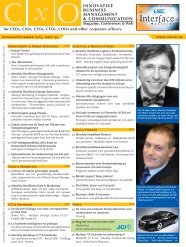Raad der Wijzen maakt Europese stand van zaken - CxO
Raad der Wijzen maakt Europese stand van zaken - CxO
Raad der Wijzen maakt Europese stand van zaken - CxO
You also want an ePaper? Increase the reach of your titles
YUMPU automatically turns print PDFs into web optimized ePapers that Google loves.
Change Management<br />
Let the Games Begin<br />
Are you contemplating or already involved<br />
in a reorganisation, the implementation<br />
of a new system, a merger?<br />
Then prepare for failure! Indeed, as<br />
demonstrated by a PwC/MORI survey,<br />
70% of change programmes do not succeed<br />
in delivering the intended value.<br />
People Stop Change<br />
The same survey sums up the top-ten reasons<br />
for this failure, and nine of them<br />
relate to people. They include: competing<br />
resources, functional boundaries, change<br />
skills, middle management and communication.<br />
So companies realise the importance<br />
of human behaviours and staff<br />
motivation for the success of their change<br />
programmes, yet they give them only<br />
a fraction of the attention that is paid to<br />
processes, finance and IT.<br />
Change Olympics<br />
So what do you have to do in terms of<br />
Change Management? To make an analogy<br />
with the world of sports: your change<br />
initiative can be a Sprint, a High Jump,<br />
a Marathon or a Decathlon, based on its<br />
complexity and duration.<br />
Outsourcing a single function and bringing<br />
a new product to the market are typical<br />
Sprints: of low complexity and short<br />
duration. Time overrun is your worst enemy.<br />
So narrow the (IT) scope of changes<br />
to a minimum. Do not spend too much<br />
time explaining the case for change, let<br />
the situation speak for you. Introduce the<br />
change with a shock-wave. The message<br />
is: “We must catch up; we are behind.”<br />
Adopt a directive lea<strong>der</strong>ship style, stating<br />
clearly what you want people to do.<br />
Mergers and acquisitions are typical High<br />
Jumps: of high complexity and short duration.<br />
High Jumps are characterised by<br />
consi<strong>der</strong>able employee stress and job<br />
security issues. So prioritise key changes<br />
into a critical mass. Identify which<br />
Management & Human Resources<br />
Stephan Podevyn and Barbara Van Rymenant<br />
Advisory Consulting Financial Services – PricewaterhouseCoopers<br />
existing change programmes can be<br />
stopped or delayed. Implement a smallscale<br />
project within 30 days to send the<br />
speed message. Have top management<br />
lead the change, but put high-potential<br />
middle managers into key positions early<br />
on the programme. Anticipate suppressed<br />
resistance to fall out later on. Plan<br />
for continuity of business and customer<br />
service levels.<br />
Cultural change implementations or Total<br />
Quality Management projects are typical<br />
Marathons: of low complexity and long<br />
duration. This is about sustaining momentum.<br />
So phase the changes to deliver<br />
new improvements regularly. Expect to<br />
keep updating the vision to new management<br />
requirements, competitive needs<br />
and technological developments. Actively<br />
manage staff retention on the project.<br />
Minimise parallel running of old and new.<br />
Combat change fatigue by periodic bursts<br />
of communication, varying medium and<br />
message. Reinforce new behaviours with<br />
recognition and reward programmes.<br />
Corporate transformations or international<br />
systems implementations are typical<br />
Decathlons: of high complexity and long<br />
duration. You have to be superhuman to<br />
win this one! Break big changes into smaller<br />
ones. Create a change staircase over<br />
a three-to-five-year timeline to link the<br />
Managing the change.<br />
While going through change, people follow a typical curve:<br />
changes. Make sure to run pilots or usability<br />
labs, they send the message that<br />
things are changing. Create a network of<br />
change agents. Rotate people through the<br />
team, but ensure continuity of the Change<br />
Sponsor and Manager. Adopt an inclusive<br />
lea<strong>der</strong>ship style, stressing the importance<br />
of involvement. Use hard facts from market<br />
intelligence and customer feedback to<br />
overcome complacency, and raise urgency.<br />
Invest heavily in end-user validation,<br />
team building and training.<br />
Knowing your Change Path<br />
is not enough<br />
Regardless of the nature of your initiative,<br />
we believe you have to fulfil three<br />
prerequisites:<br />
1. an agreed-upon Case for Change, outlining<br />
the risks and costs of not changing;<br />
2. a clear Vision of what you want to<br />
achieve, including the ‘What’s-In-It-<br />
For-Me?’ for all those impacted, and<br />
taking into account the change readiness<br />
of the different stakehol<strong>der</strong><br />
groups;<br />
3. commitment and visible support of<br />
lea<strong>der</strong>ship.<br />
When prepared like this, you will be able<br />
to participate successfully in any of the<br />
above Olympic Change disciplines.<br />
<strong>CxO</strong> Magazine | February – March 2008 | www.cxonet.be 1
















